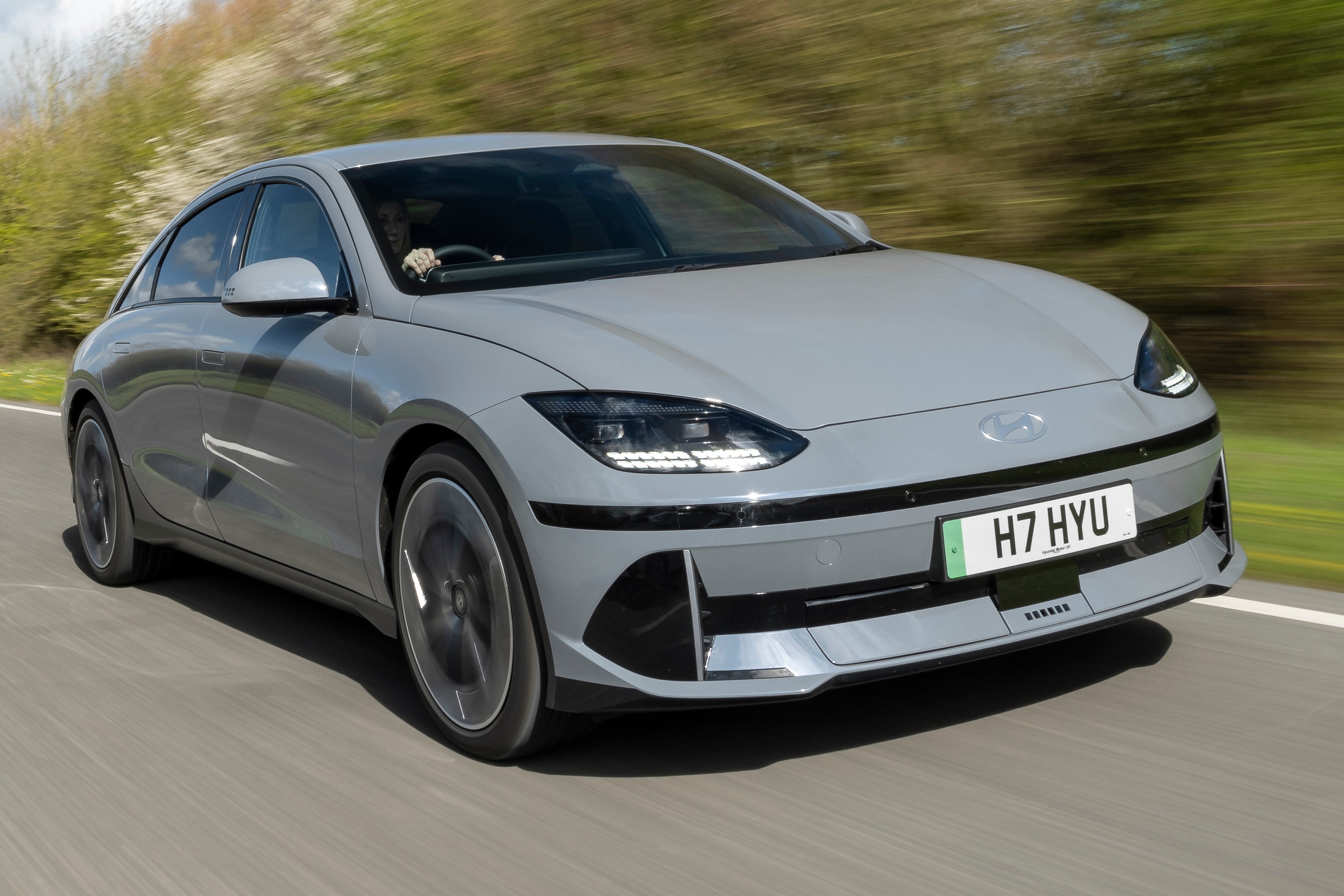Hyundai Ioniq 6 Review 2024
Written by Richard Aucock
Quick overview
Pros
- Dramatic styling makes a bold statement
- Impressive battery range and charging speed
- Strong performance from the AWD version
Cons
- Firm ride on 20-inch alloy wheels
- Swoopy looks have an impact on practicality
- Technology and infotainment can be overwhelming
Overall verdict on the Hyundai Ioniq 6
“The Hyundai Ioniq 6 is one of the most distinctive electric cars around, thanks to its dramatic looks. It offers plenty of battery range and lots of technology, too. Being a saloon limits practicality, but this is still a strong alternative to the ubiquitous Tesla Model 3.”

No pressure, but the Hyundai Ioniq 6 was named World Car of the Year, World Car Design of the Year and World Electric Car of the Year for 2023. It means this electric car has a lot to live up to.
Hyundai is not messing around when it comes to creating new electric cars, with the Ioniq 6 another dramatic addition to its range. Rather than the 1970s influences found on the Ioniq 5 SUV, Hyundai has partly been inspired by older ‘streamliners’ from the 1930s.
The result is an electric saloon that looks like very little else on the road. There is even a hint of classic Porsche 911 Turbo in the shape of the ‘whale tail’ spoiler at the rear. Compared to rivals like the BMW i4, Polestar 2 and Tesla Model 3, the Hyundai Ioniq 6 is certainly the car that will turn the most heads.
Such swoopy looks may boost aerodynamic efficiency, and indeed kerb appeal, but they do limit space inside. Headroom is tight in the Ioniq 6, even for average-height passengers, and the boot is awkward to access through a narrow saloon-style opening.
Although the Ioniq 6 is slightly less radical inside, it still packs two large 12.3-inch display screens and endless amounts of technology. The standard list of equipment is extensive, to the point where the options on the infotainment display have their own search function.
Add in the amount of beeps and bongs from the various warning systems, and the Ioniq 6 can border on technological overload.
Look beyond this, however, and the electric car underneath is a hugely effective one. Hyundai’s E-GMP platform gives the Ioniq 6 a sizable 77.4kWh battery, meaning an official driving range of up to 338 miles. The ability to go from 10-80 percent charge in only 18 minutes with the right device adds to the appeal of the Ioniq 6 for those covering lots of miles.
Being a long-distance cruiser suits the nature of the Ioniq 6. This may be a quick car, with the AWD model able to accelerate from 0-62mph in 5.1 seconds, but it is not a sporty one. There is good body control and plenty of grip, but the Ioniq 6 is not particularly engaging to drive, despite what its firm ride might suggest.
The Hyundai Ioniq 6 is compromised, to a degree, by the pursuit of bold styling and all the technology inside. Yet at its core, this is a high-performing electric saloon that offers a real alternative to the more predictable options.
Looking for a used car for sale? We've got 100s of Hyundai Approved Used Cars for Sale for you to choose from, including a wide range of Hyundai Ioniq 6 cars for sale.
Is the Hyundai Ioniq 6 right for you?
If you want an electric car that makes a dramatic statement, rather than blending into the background, the Hyundai Ioniq 6 is the EV for you. It looks like almost nothing else on the road, being a blend of 1930s streamliner and retro Porsche to look at.
Add Hyundai’s impressive battery technology to the package, along with an interior packed with technology, and it makes for an appealing option. Being cheaper than rivals such as the BMW i4 helps, too.
Keep in mind that reduced practicality is the price you pay for swoopy styling, and an electric SUV will be a better option if space is a priority.
What other cars are similar to the Hyundai Ioniq 6?
The electric car market continues to heat up, with the number of rivals to the Hyundai Ioniq 6 growing by the month. Hyundai’s impressive Ioniq 5 SUV shares the same platform as the Ioniq 6, as do the Kia EV6 and Genesis GV60.
When it comes to direct competitors, the BMW i4, Tesla Model 3 and Polestar 2 are the most similar EVs in stature and status. Volkswagen’s new ID.7 will join the ranks of Ioniq 6 alternatives soon, too.
Given its dramatic styling and performance, you could even think of the Hyundai Ioniq 6 as being a cut-price alternative to a Porsche Taycan.
Comfort and design: Hyundai Ioniq 6 interior
“Slightly less dramatic than the exterior, the Ioniq 6 still appears bold and modern on the inside.”
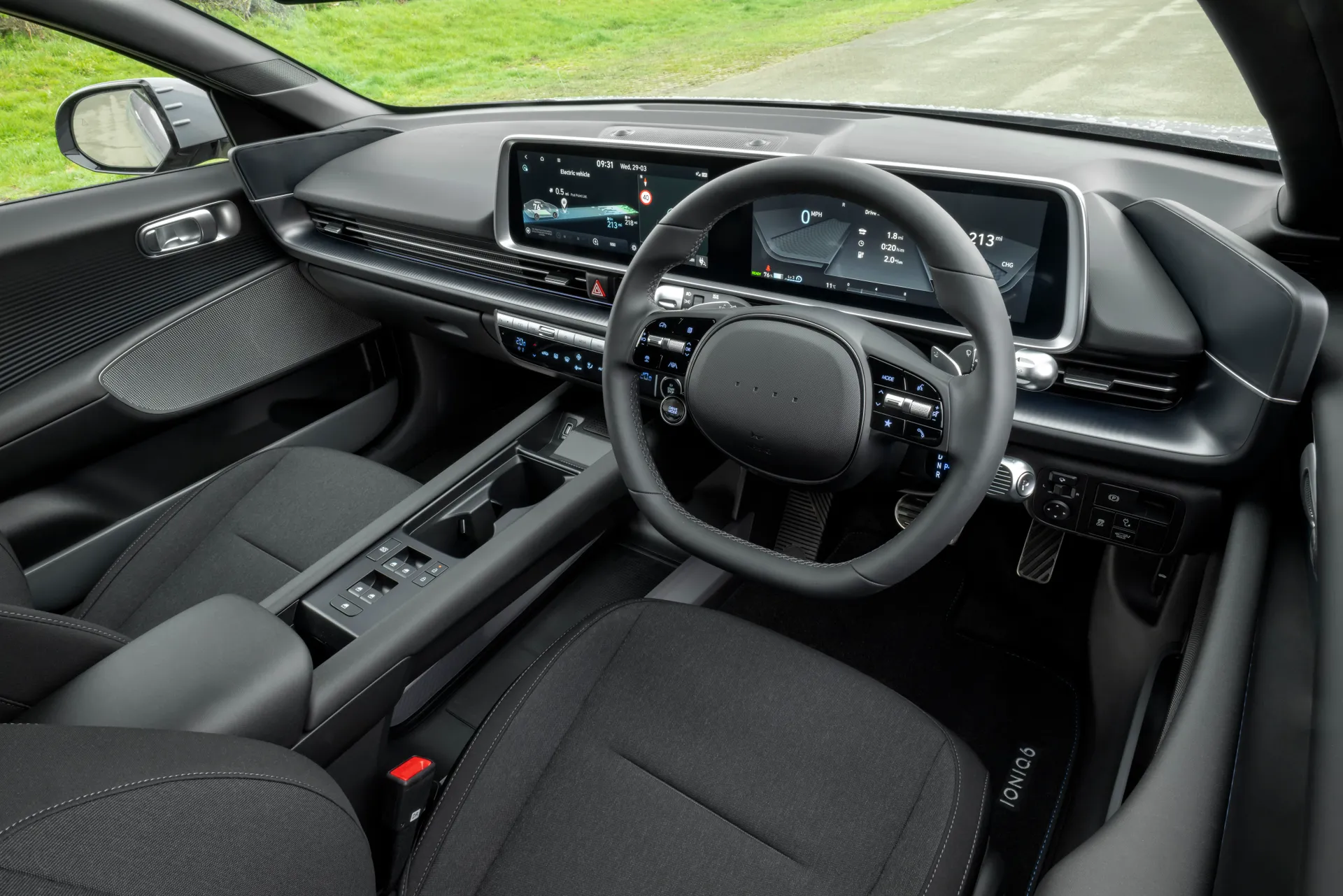
Although the cabin design of the Ioniq 6 shares much with Hyundai’s own Ioniq 5, there are a number of subtle differences between the cars. The four-door Ioniq 6 gains a large centre console between the front seats, as opposed to the Ioniq 5’s open-plan arrangement.
Its door trims are also heavily sculpted, with ambient lighting and floating armrests included.
The front seats come with plenty of power adjustment, including electrically adjustable lumbar support. Both the front and outer rear seats are heated, whilst Ultimate and First Edition models gain a ventilation function. A heated steering wheel is fitted for good measure on all versions.
A ‘Relaxation’ setting even allows the front pair of seats to fully recline – helpful if you fancy a nap while the car is charging.
Although the seats themselves are comfortable, the low roofline of the Ioniq 6 can limit the possible seating positions. Even with the seats on their lowest setting, drivers of average height can feel they are close to the headlining.
Quality and finish
As one of the top models in the Hyundai range, the Ioniq 6 has an upmarket image. Its interior supports this, thanks to use of colour-changing ambient lighting, plus deeply sculpted door trims.
Cloth seat trim is standard on Ioniq 6 Premium models, with leather used for Ultimate versions. The First Edition comes with an intriguing combination of leather and tartan fabric.
The overall impression is of a high-end electric vehicle, with most of the major touchpoints giving off the air of quality and durability.
Look harder and some parts of the Ioniq 6’s cabin seem less than premium. The large centre console feels surprisingly cheap, with hard plastics used for the trim and buttons used to operate the windows. The Hyundai is still streets ahead of a Tesla for interior quality, though.
Ultimate and First Edition models come with an array of four LEDs in the centre of the steering wheel. These can display the battery level when charging, and change colour when you select a new driving mode.
Infotainment: Touchscreen, USB, sat nav and stereo in the Hyundai Ioniq 6
The Hyundai Ioniq 6 is a feast for tech lovers, with a 12.3-inch infotainment touchscreen combined with a 12.3-inch digital instrument panel. This is the same setup as found in the Hyundai Ioniq 5, but with a more understated layout.
Both the digital instrument panel and touchscreen look smart, and the infotainment is fairly rapid to respond to inputs. There are a lot of options and menus included, though. The system even has a search function to help locate what you need.
A separate physical controller on the centre console would help, rather than needing to use the touchscreen for everything, as it can become overwhelming.
Unlike some rivals, Hyundai has retained touch-sensitive buttons for the climate control system below the main touchscreen. These are still a little fiddly to use, but far better than having to delve into endless menus. Some physical shortcut buttons for the infotainment system are also included.
There is just one USB port for connecting devices in the front of the Ioniq 6, along with two USB-C ports in the centre console that are capable of charging. An additional USB outlet is available for rear-seat passengers, too.
Apple CarPlay and Android Auto connectivity is standard, while all models come with a wireless smartphone charging pad.
Ultimate and First Edition versions can be specified with digital side-view cameras instead of traditional exterior mirrors. These send a feed to displays at either end of the dashboard, but the image can be distorted by poor weather or headlight glare.
A rear-view camera is included on Premium models, with others gaining a surround-view setup.
Space and practicality: Hyundai Ioniq 6 boot space
A relatively large car, the Hyundai Ioniq 6 is a mixed bag when it comes to overall practicality.
Space in the front is generous, with plenty of legroom, along with a wide centre console that means no bashing elbows. But a dramatic swooping roofline does eat into headroom, for drivers and passengers of even average height. The Ultimate version of the Ioniq 6 comes with a standard sunroof, further eating into head space in the front.
This continues in the rear, with taller passengers likely to find their head close to the roof. However, they will at least have acres of legroom, thanks to the Ioniq 6’s long wheelbase.
Using a traditional saloon-style opening means access to the 401-litre boot capacity is narrow and awkward. The rear seats do split and fold to help transport larger items, however. Rear-wheel-drive models come with an additional 45-litre front ‘frunk’, while all-wheel drive versions see this space reduced to a paltry 14.5 litres.
Interior storage is generous, with a large open area beneath the centre console, along with big door bins. The glovebox cleverly slides out like a drawer, making it more useful.
Handling and ride quality: What is the Hyundai Ioniq 6 like to drive?
“Despite its looks, the Hyundai Ioniq 6 is not a sports car. Instead, it makes for a refined and effective driving experience, with a focus on passing the miles without any major dramas. ”
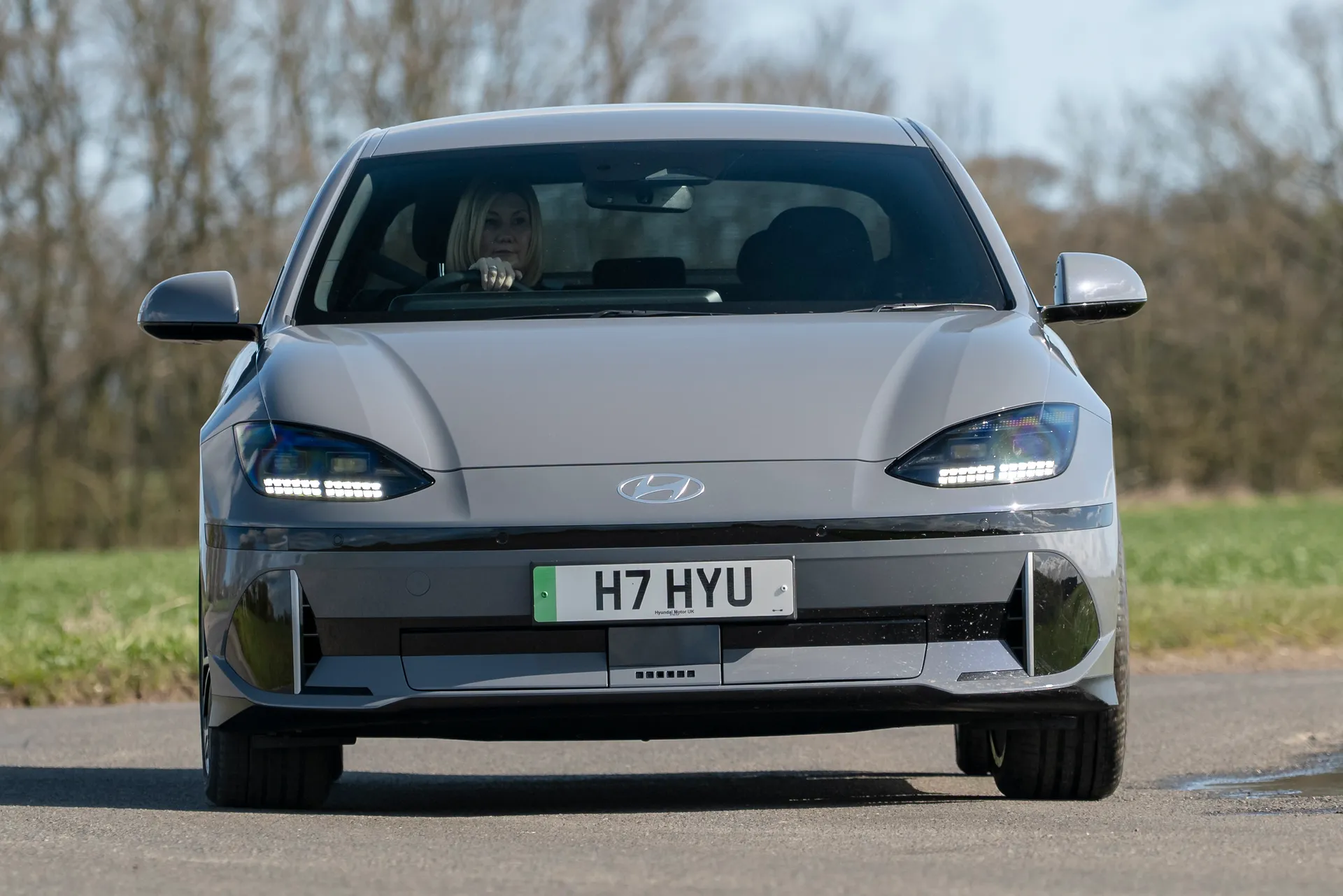
Keep in mind that the Hyundai Ioniq 6 is a relatively heavy car, tipping the scales at around 2000kg. But Hyundai has done a good job of disguising this mass, and even making the Ioniq 6 feel smaller than its sizable exterior dimensions. It becomes an easy car to drive, albeit not one that goads you into going quickly.
Body control is strong, aided by the weight of the batteries being low in the car, but there is not a great deal of feedback through the steering. Despite its sporty looks, the Ioniq 6 works as a long-distance cruiser, rather than a performance car.
The only thing that counts against this cruising nature is the tautness of the suspension. There are no adaptive dampers to select comfort levels, and the overall effect is one of firmness – not helped, perhaps, by the standard 20-inch alloy wheels.
There are paddles behind the steering wheel to vary the level of regenerative braking. This can be all the way from ‘one-pedal’ driving, through to free-wheeling. Alternatively, an automatic setting will let the Ioniq 6 use various sensors to determine the optimum level of regenerative braking to use.
A curving roofline limits visibility, and the wiper-less rear window can be hard to see out of when it rains. There are cameras and parking sensors to help, though, along with those optional digital door mirrors.
What motors and batteries are available in the Hyundai Ioniq 6?
At present, the Hyundai Ioniq 6 is offered in the UK with a choice of two powertrains, both of which use the same 77.4kWh battery pack mounted beneath the floor.
Rear-wheel drive is standard on the entry-level Ioniq 6, using a single electric motor to generate 228PS. Although this may not sound massive, 350Nm helps the RWD Ioniq 6 cover the 0-62mph sprint in a respectable 7.4 seconds.
The all-wheel drive version of the Ioniq 6 adds an electric motor to the front axle, taking total power output to 325PS. This is combined with a huge 605Nm of torque, allowing the car to accelerate from 0-62mph in just 5.1 seconds, aided by the all-wheel-drive traction. Such performance will be a bonus to those considering a move from the very rapid Tesla Model 3.
Engaging Sport mode sees the Ioniq 6 primed for performance, with near instantaneous acceleration in the AWD model. For those who want even more speed, Hyundai has already teased a quicker RN22e performance model, using the powertrain from the Kia EV6 GT.
With all Hyundai Ioniq 6 models currently using the same 77.4kWh battery pack, there are only minor differences between trim levels when it comes to the official driving range.
According to WLTP tests, rear-wheel-drive versions of the Ioniq 6 can cover up to 338 miles when fully charged. Opting for the more powerful all-wheel-drive model sees this reduced slightly to 322 miles.
Such figures should always be taken with a pinch of salt, as they have been produced in laboratory conditions for ease of comparison. The reality on the road will inevitably differ, and be affected by factors such as how much you use the climate control and which driving mode you select.
Refinement and noise levels
Being a battery electric car gives the Hyundai Ioniq 6 a notable advantage when it comes to refinement, as does its aerodynamic styling. The latter results in an almost near total absence of wind noise, while the electric powertrain is muted in most driving conditions.
The only notable exterior noise comes from the tyres, with both the Premium and Ultimate models wearing large 20-inch alloy wheels. This can be disguised by the audio system, though. It all makes for a particularly refined driving experience.
Safety equipment: How safe is the Hyundai Ioniq 6?
When the Hyundai Ioniq 6 was tested by the Euro NCAP safety organisation, it was awarded the maximum five-star rating. This included an impressive 97 percent score for adult occupants, plus 87 percent for children.
The Ioniq 6 comes with a host of advanced safety equipment, including assisted driving systems. All versions include forward collision avoidance, lane keeping assistance and Hyundai’s Highway Drive Assist, which can maintain a set speed on motorways and help perform overtaking manoeuvres.
Intelligent Speed Limit Assist is also standard, but can be obtrusive. It beeps at every speed limit change, or if you accidentally exceed the speed limit by a fraction. To avoid this, you need to turn it off at the start of each journey, which requires a trip through several menus.
Charging times and costs: What does a Hyundai Ioniq 6 cost to charge?
“Hyundai’s 800-volt technology means charging the Ioniq 6 from 10-80 percent could take just 18 minutes using the right charger.”
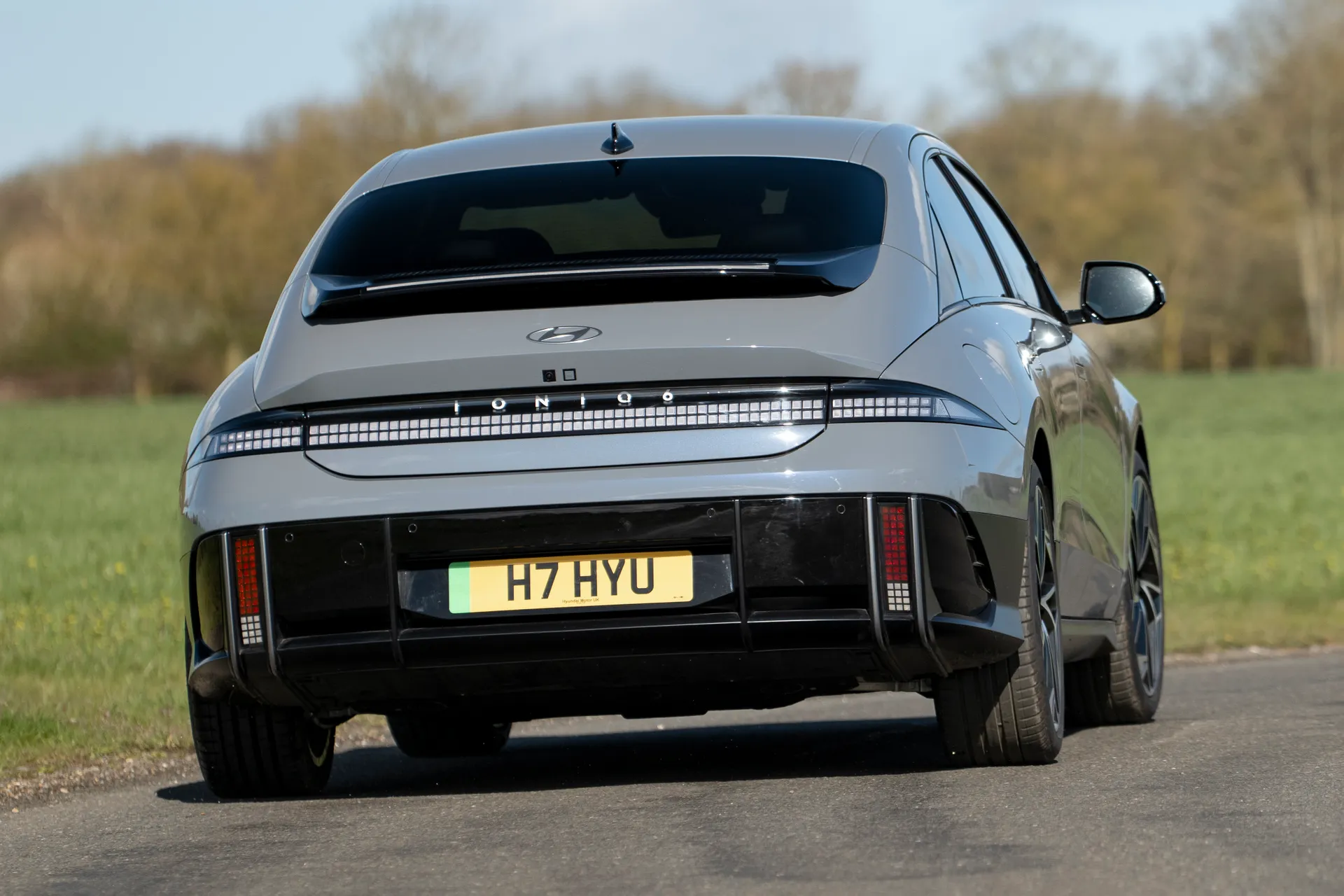
As a car designed for long journeys, Hyundai has equipped the Ioniq 6 with battery architecture to minimise the pain of charging.
Using the fastest 350kW ultra-rapid charging devices will see the Ioniq 6 go from 10-80 percent in just 18 minutes. Opting for a more common 50kW rapid charger will see over an hour needed for the same replenishment. Such speedy charging devices will be costly to use, however.
This makes buying a home-charging wallbox a sensible investment. Although an 11kW wallbox will take more than seven hours to fully recharge the Ioniq 6, it will be a fraction of the cost compared to using public devices.
All Hyundai Ioniq 6 models come with vehicle-to-load functions, meaning domestic devices can be powered directly from the battery pack.
How reliable is the Hyundai Ioniq 6?
Like most electric cars, the Hyundai Ioniq 6 is relatively simple when it comes to mechanical parts. This reduces the number of things that can go wrong, theoretically helping improve reliability and reduce servicing costs. There is an awful lot of technology integrated into the Ioniq 6, but this is the first Hyundai to be offered with over-the-air software updates.
Hyundai sells the Ioniq 6 with a five-year / unlimited-mileage warranty as standard, with the battery covered separately for eight years or 100,000 miles.
Insurance groups and costs
As a flagship electric saloon, with considerable performance and technology included, the Hyundai Ioniq 6 will be more expensive than many cars to insure.
The rear-wheel-drive Premium model comes with a group 36 insurance rating (out of 50 groups in total), with the equivalent Ultimate version in group 37.
Choosing the all-wheel-drive Ioniq 6 with its extra power takes things up to insurance group 41, regardless of which trim level you go for.
VED car tax: What is the annual road tax on a Hyundai Ioniq 6?
As a battery electric car, the Hyundai Ioniq 6 produces no emissions from the exhaust tailpipe. Not that it even has an exhaust in the first place...
This means that the Hyundai Ioniq 6 qualifies for free VED (road tax). Given its list price is in excess of £40,000 across the Ioniq 6 range, this makes for a substantial saving compared to a comparable petrol or diesel car.
How much should you be paying for a used Hyundai Ioniq 6?
“The Hyundai Ioniq 6 is already appearing on the used market, with prices from less than £37,000.”
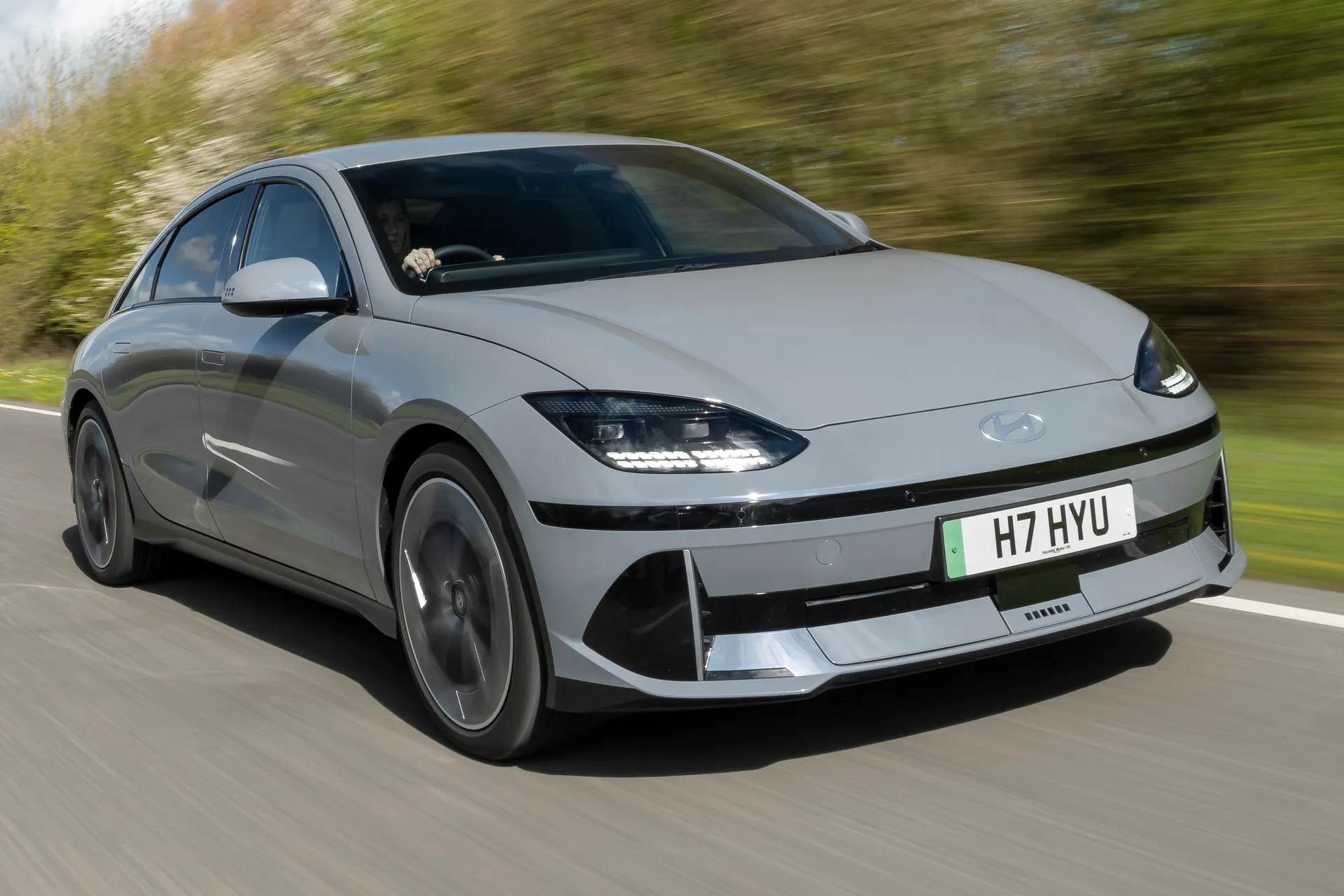
Although the Hyundai Ioniq 6 is relatively new, examples have already filtered through to the secondhand marketplace.
An Ioniq 6 Premium, with less than 10,000 miles on the odometer, can be bought for less than £37,000. The rarer First Edition models are more expensive, available from around £47,000.
An example of the Hyundai Ioniq 6 Ultimate will be harder to locate, having been launched more recently. Expect to pay a minimum of £50,000 for one.
Trim levels and standard equipment
The Hyundai Ioniq 6 is offered in two trim levels, both of which are generous in terms of the amount of standard equipment included.
The Ioniq 6 Premium is the starting point for the range, with 20-inch alloy wheels, LED headlights with high beam assist, LED daytime running lights and privacy glass. The neat flush-fitting door handles do have to be opened manually, though.
Cloth upholstery is standard for the interior, with the front and rear seats both heated. Electric adjustment for the front seats is also included, along with electric lumbar adjustment and a heated steering wheel. A 12.3-inch digital instrument panel is combined with a 12.3-inch multimedia touchscreen.
Dual-zone climate control, automatic windscreen wipers, front and rear parking sensors, and a rear-view camera are all standard. Smart cruise control, smart regenerative braking and semi-autonomous Highway Driving Assist Level 2 are other key features of the car.
Moving up to the Hyundai Ioniq 6 Ultimate adds even more equipment to the specification. Its flush door handles pop-out automatically, while the driver’s seat adjustment gains a memory function. Front ‘relaxation’ seats come with ventilation, with leather upholstery used throughout the cabin. A sunroof is included, too.
Blind-spot monitoring, a head-up display, surround-view camera and remote smart parking assist are other technology features. The steering wheel benefits from LED lighting, while parking collision avoidance joins the list of safety equipment.
When initially launched, Hyundai offered a First Edition of the Ioniq 6. This came with 20-inch matte black alloy wheels, black Hyundai logos, gloss black bumpers and an exterior adaptor for the vehicle-to-load system.
On the inside, the First Edition has leather seats with tartan fabric inserts, along with special floor mats.
Ask the heycar experts: common questions
What is the battery range of the Hyundai Ioniq 6?
How fast is the Hyundai Ioniq 6?
How long is the warranty on the Hyundai Ioniq 6?
Get our latest advice, news and offers
Keep me updated by email with the latest advice, news and offers from heycar.
By submitting you agree to our privacy policy
